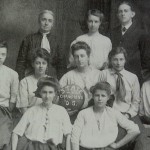Since 2003, Team Major Taylor has fueled competition at Bloomington’s annual Little Five Hundred bicycle race. The namesake of the racially diverse team was a hero from the golden age of cycling at the turn of the twentieth century.
During an era when bicycle racing was the nation’s preeminent sport—on the level of contemporary football or basketball—Indiana-born Marshall Walter, or “Major,” Taylor was the sport’s superstar.
Arguably the fastest cyclist in the world from 1896 to 1900, Taylor may be considered the first black celebrity athlete, earning the relatively enormous sum of $35,000 a year at his height.
The glory was bittersweet, however, when considered in light of the enormous racial discrimination the “dusky cyclone”, as he was nicknamed, had to battle along the way. Born on an Indiana farm in 1878, Taylor moved as a child to Indianapolis, where his father worked as a coachman to a wealthy family, who gave Taylor his first bike. The young boy was hired to perform cycling tricks outside an Indianapolis bike shop, while wearing a soldier’s uniform—earning him the alias “Major.”
Winning his first race at age 14, Taylor started to encounter what he called the “dreadful monster prejudice,” when the Indianapolis YMCA refused to admit him as a member, and he was banned by the city’s velodromes.
Taylor moved to Middletown, Connecticut in 1895, a cycling industry hub, and home of his manager Louis “Birdie” Munger’s Worcester Cycle Manufacturing Company. Taylor’s series of record-breaking milers began in 1896; a win in Montreal in 1899 launched him to the position of the second black world record-holder in history, after boxer George Dixon.
Settling in Worcester, Massachusetts though competing worldwide, Taylor broke world records in seven different bicycle events in 1899. Although the “Worcester whirlwind” excelled at the short sprint, he was known to take on any cycling challenge, including a six-day, 1,732-mile course at Madison Square Garden.
Regardless, or perhaps because of, his dominance in the sport, Taylor faced relentless, sometimes violent ostracism from competitors, organizers and fans. The League of American Wheelmen, the sport’s main organ, excluded blacks from membership. Even off the track, the world champion found himself reduced to a racial epithet when purchasing a home in a tony Worcester neighborhood.
The weary Taylor retired from cycling in 1910, and made several unsuccessful business investments, including the self-publication of his autobiography. Taylor was survived by one daughter when he died in 1932, and was buried in an unmarked grave. In 1948 a group of former bike racers raised funds to have the champion’s remains moved to a more prominent spot in Chicago’s Mount Glenwood Cemetery.
In Indianapolis, the Major Taylor Velodrome, constructed for the 1982 National Sports Festival, was the city’s first structure built with public funds to be named for a black person.






















